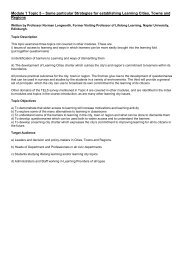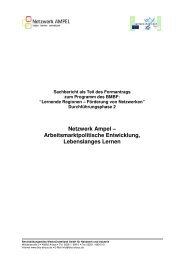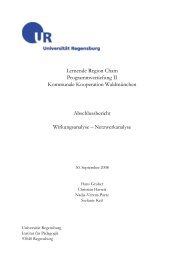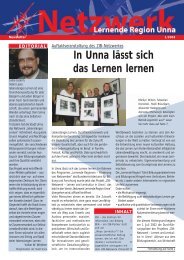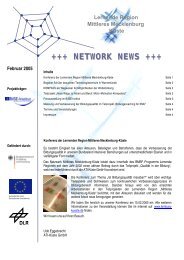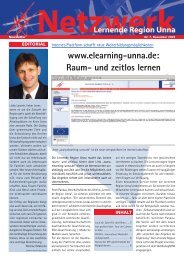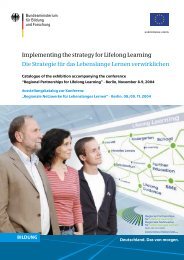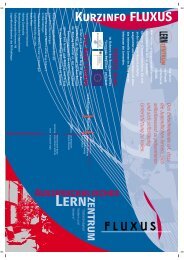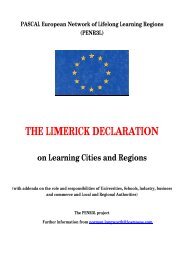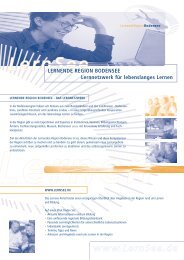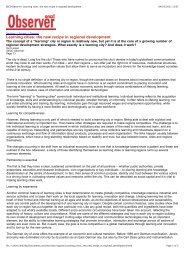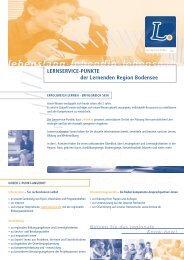SWOT-analysis as a basis for regional strategies - EUROlocal
SWOT-analysis as a basis for regional strategies - EUROlocal
SWOT-analysis as a basis for regional strategies - EUROlocal
Create successful ePaper yourself
Turn your PDF publications into a flip-book with our unique Google optimized e-Paper software.
1. Introduction<br />
The aim of this pilot-project h<strong>as</strong> been to <strong>as</strong>sess the utilisation and usefulness of<br />
<strong>SWOT</strong> <strong>analysis</strong> (Strengths, Weaknesses, Opportunities and Threats) in strategic<br />
planning <strong>as</strong>sociated with <strong>regional</strong> programmes across the Nordic countries. Within<br />
this context this project h<strong>as</strong> focused on both national development projects<br />
(tillväxtavtal in Sweden, <strong>regional</strong>e utviklingsprogrammer in Norway and<br />
aluekehittämisohjelmat in Finland) and Structural Funds programming (Objectives 1<br />
and 2, <strong>as</strong> well <strong>as</strong> Interreg Community Initiatives). The central questions to be<br />
addressed here are:<br />
• What is the methodological background behind the introduction of <strong>SWOT</strong><br />
<strong>analysis</strong> into these programmes?<br />
• What are the consequences of these methodological choices <strong>for</strong> actual strategy<br />
<strong>for</strong>mation?<br />
• Can we determine a significant value added from the utilisation of <strong>SWOT</strong><br />
<strong>analysis</strong> <strong>as</strong> a strategic instrument? Does the utilisation of <strong>SWOT</strong> contribute to<br />
learning in the regions in question?<br />
• Does <strong>SWOT</strong> function <strong>as</strong> an instrument, which brings out and accentuates the<br />
<strong>regional</strong> specificities in a sufficient manner in order that the region in question<br />
is actually identifiable by this <strong>analysis</strong> and <strong>SWOT</strong> contributes to enhancing the<br />
potential <strong>for</strong> competitiveness and endogenous <strong>regional</strong> development in the<br />
region in question?<br />
As well <strong>as</strong> providing an <strong>analysis</strong> of the current situation in terms of the utilisation of<br />
<strong>SWOT</strong>, the conclusions section will offer some further indications <strong>as</strong> to how this<br />
policy instrument could be better utilised <strong>for</strong> <strong>regional</strong> programming processes.<br />
1.1 Programmes chosen <strong>for</strong> <strong>analysis</strong><br />
The programmes chosen <strong>for</strong> <strong>analysis</strong> here share the common characteristic of<br />
functioning <strong>as</strong> a strategic policy instrument <strong>for</strong> the purposes of planning and <strong>regional</strong><br />
development. As a general rule programmes were chosen on a representative b<strong>as</strong>is:<br />
those included in the study can be seen <strong>as</strong> “ideal types” of <strong>regional</strong> development<br />
programmes in the country in question, in that they present key characteristics of<br />
programming work in general, i.e. factors such <strong>as</strong> programming and partnership.<br />
Another factor considered in choosing the programmes w<strong>as</strong> their location, both in<br />
terms of the north-south/e<strong>as</strong>t-west dimension within the country in question and on<br />
the b<strong>as</strong>is of the functional and political role of the region, in an attempt to choose a<br />
selection of programmes that would allow some general conclusions to be drawn on<br />
the nature of programming documents (and the <strong>SWOT</strong> <strong>analysis</strong> they included) <strong>as</strong><br />
policy instruments of Nordic <strong>regional</strong> development.<br />
In addition to the national context, elements of synergy between the national and<br />
European level were sought. For instance, the fact that the Finnish and Swedish<br />
domestic programmes represent regions also included in the EU’s Objective<br />
programmes allows <strong>for</strong> a more comprehensive approach to the question of <strong>regional</strong><br />
development programming in these countries. As one of the constituent parts of EU<br />
7



